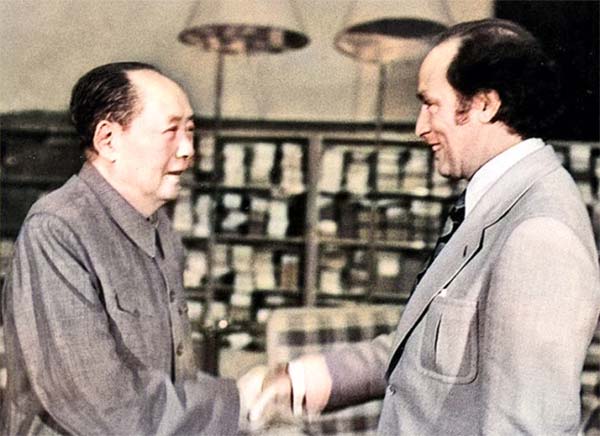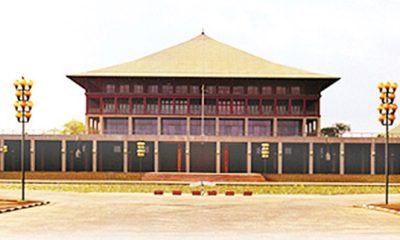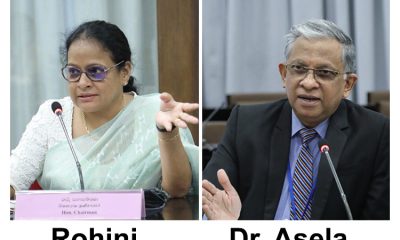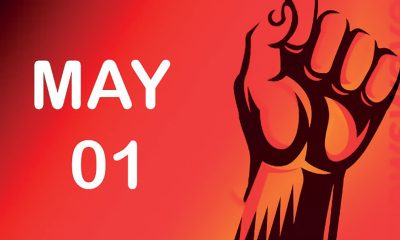Features
Biden and Trump vie for American Workers, Canada and India spar over Sikhs
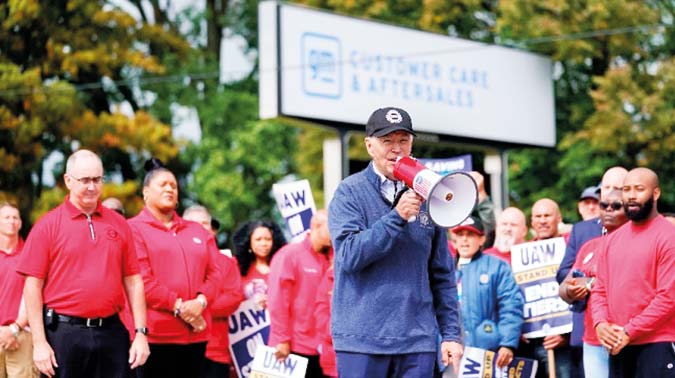
by Rajan Philips
After burdening this column by writing serially on political reforms, I was looking for a break from, yes, the Constitution. The Canada-India spat over Sikhs seemed a good topic for a thousand words, especially after the long distance lecture by Sri Lanka’s Foreign Minister to the government of Canada. The most that the lecture managed to accomplish was to make a splash across the Palk Strait in Chennai. Then came the breaking news of US President Joe Biden joining the striking auto-workers on their picket line in Detroit, Michigan. That is quite historic, not only for an American President but also for a head of state anywhere, including China.
It is also a very therapeutic topic to write about, inasmuch as in the world of politics it is usually one step forward and at least two of them backward. You grasp and make the most of whatever foot that progressively steps forward. On the other hand, it may not be therapeutic to write about President Ranil Wickremesinghe’s politics, but it is a Sunday hazard that some of us have grown addicted to. Mr. Wickremesinghe has of late been morphing into a flying president. Let us spare him this week while taking a break from the constitution.
Strike Solidarity
On Tuesday, September 26, President Joe Biden did something that no US President before him has done or would have thought of doing. He may have also set a precedent that future presidents will likely be forced to follow. Biden flew from Washington to Detroit and joined the striking United Auto Workers (UAW) union members who were on a picket line outside a General Motors’ Redistribution Centre in Wayne County, Michigan. Donning a UAW blue hat, the President mounted a wooden platform and used a bull horn to tell the workers, “You deserve what you’ve earned, and you’ve earned a hell of a lot more than you’re getting paid now. Then his middle class theme: “The unions built the middle class. That’s a fact. Let’s keep going.”
Not quite the socialist message, but a message you will hardly hear from another Head of State anywhere in the world today. Alexandria Ocasio-Cortez (AOC), the Democratic Congresswoman from New York and the pretty face of millennial socialism, would be pleased. She once remarked, as we were reminded recently in this paper, that she and Joe Biden will not be in the same party in any other country. In many other countries she could be in jail.
But that is America and where Ms. Cotez is assured of a virtual lifetime Congressional seat in a progressive borough, in the heart of New York City. It will not be easy to move up the American political ladder – as Senator, State Governor, or even US President, based solely on progressive politics and hard work. The US political system is stacked against people like AOC by the weight given to America’s insular hinterland in the Senate and in the Electoral College.
Reactionary and systemic stacking against progressives, let alone socialists, is not unique to America. That has been present from the beginning of representative democracy in any country and every country. And attempts at violently overthrowing representative democracy have produced cures that are worse than the ailments.
Yet Ms. Cotez, and her gallant Squad in Congress (that began with four women of colour in 2018 and has now grown to eight including two men) can make a world of difference for many Americans from where they are today. One of AOC’s main initiatives has been promoting the Green New Deal plan for fighting climate change along with fighting economic and racial injustice.
Although President Biden did not endorse the Green New Deal, he had no qualms in borrowing ideas from it for his own Plan for a Clean Energy Revolution and Environmental Justice. His signature legislative achievement is the euphemistically named Inflation Reduction Act (IRA), which includes specific measures for combating climate change. One of the key measures is at the core of the current labour dispute in the auto industry, and that is the shift from gasoline-driven cars to electric vehicles (EVs).
The Biden Plan goal is to make half of all new vehicles sold in America to be zero-emissions vehicles by 2030. That means greater production of EVs by auto makers, along with government commitment to providing federal funding and tax incentives, and installing 500,000 chargers to make EVs accessible nationwide. More so in rural America, the bastion of the political right, where 20% of Americans live and account for 70% of road miles of national travel. Just like the political lopsidedness. Now to the strike dynamic.
America’s big three in automakers (GM, Ford and Stellantis, which owns Chrysler) are laggers in EV manufacturing. They lag behind Tesla, BYD Auto and the Volkswagen Group, the three global leaders, by quite a distance. As they plan to repurpose their production base to increase EV production, the big three face competition from foreign automakers who are also eligible for the IRA tax incentives so long as their factories are in the US, Canada or Mexico. Some of them, mostly Japanese firms, already have their bases in one or more of the three free-trade countries. Also, unlike the big three, the foreign firms and the EV manufacturers like Tesla do not have unionized workers.
The top three are insistent that they cannot afford to pay the current union demands for wage increases and benefits, given the level of investments required for transitioning to EV; nor can they be competitive with automakers without unionized workforce. On the other hand, the union claims are based on the sacrifices workers made during the 2007-2008 financial crisis in order to keep the automakers solvent and in business.
The workers now want restoration of overtime work and retirement benefits, ending of wage differences between contract and permanent workers, as well as protection against potential labour retrenchment as part of EV production. The huge profits that the auto companies made during the Covid pandemic and the inflated salaries and bonuses that flowed to company CEOs, are not lost on the unions and the workers. Nor are they unaware of the huge financial support and tax benefits the US government is giving the automakers to switch from gasoline to electric vehicles.
In the backdrop to the labour dispute, there are both political interests as well as technological implications. On the latter, industry observers are opining that the transition from gasoline to electric vehicles involves “the biggest technological transformation since Henry Ford’s moving assembly line started up at the beginning of the 20th century.” And the workers and their unions are determined not to get shortchanged a second time as they were at the last technological changeover, not to mention the start of the industrial revolution itself. However, there is a major difference between the age of Ford and the present time, and it is that the economy now is highly diversified and is not ‘over-determined’ by a single industry.
And then there is politics, with the presidential election coming up next year. Regardless of the Republican primary clown show and Democratic party doubters, President Biden and Donald Trump would seem to have decided that they are the de facto candidates and that it is time to start the real campaign. After President Biden’s visit to the picket line of striking union workers, Donald Trump visited Drake Enterprises, a non-union auto parts supplier in Clint Township, Michigan. Trump’s pitch is of course diametrically the opposite. He wants union workers to peel away from their leaders and vote for him because he will save their jobs by removing the requirement for shifting from gasoline to electric vehicles.
The trouble with that reactionary approach is that Mr. Trump will not find any takers for it from any of the main automakers. But Trump being Trump, he is not interested in the fallout for the auto industry or the American economy, let alone climate change. He is only interested in using any slogan to win back the workers who voted for him in 2016 in the three battleground states of Michigan, Wisconsin and Pennsylvania. Trump won all three of them in 2016 and lost them all to Biden in 2020. And Joe Biden will do everything to keep those states on his side of the tally. Including, joining a picket line.
Canada stuck between China and India
From the auto industry and presidential politics in the US, it is quite a stretch to comment on the recent spat between Canada and India over Sikhs and their politics in the two countries. But in the ‘globalized world’, everything is interconnected, hierarchically and horizontally. It is the global interconnections that Antonio Negri and Michael Hardt may seem to have captured in conceptualizing the current global order by counterposing the new global Empire (of superpowers – past, present and wannabe) and its anthesis, the new global Multitude.
One of the empirical processes driving the global multitude is the movement of people across nation-state boundaries. In this process, China and India are giant exporters of the multitude and Canada is literally caught up between them as one of the main recipients of global migrants. And the government of Prime Minister Justin Trudeau that has more immigrant ministers than any other government in the world has become the object of derision and vilification both by India and China, as well as its domestic detractors.
For the greater part of this year the Trudeau government has been facing relentless criticism from opposition parties and the media for its alleged failure to deal with Chinese interference in Canadian elections and intimidations of Chinese Canadians who are opposed to the Chinese government and its representatives in Hong Kong. The criticisms became personal and right wing attacks targeted the Trudeau family as having a soft spot for China, even harking back to then Prime Minister Pierre Trudeau’s historic 1973 visit to China as a breakout leader from the western world.
The critics conveniently forgot that for nearly three years (December 1, 2018, to September 4, 2021) the Trudeau government was delicately pre-occupied with getting the release of Michael Spavor and Michael Kovrig (the two Michaels), two Canadian citizens who were arbitrarily jailed in China, in retaliation to the detention of Meng Wanzhou, the daughter of the founder of the Chinese tech giant Huawei and its Chief Financial Officer.
Her detention, while travelling through Canada, was in response to a US extradition request for allegedly violating US sanctions against Iran. All three were finally released following a tripartite understanding between the US, China and Canada.
There was a chorus of calls for an independent public inquiry into Chinese interference. After months of back and forth, the government and the opposition have agreed on the launching of a Public Inquiry into “Foreign Interference in Federal Electoral Processes and Democratic Institutions.” The inquiry will be led by an Appeal Court Judge from the Province of Quebec, and will cover not only China but also Russia and other countries with alleged interferences.
Just when the hullabaloo over Chinese interference seemed to be quietening down, Prime Minister Trudeau dropped a bombshell in a statement to parliament on September 19, that there were “credible allegations of a potential link” between Indian government agents and the killing of 45 year old Hardeep Singh Nijjar in June, near Vancouver. Mr. Nijjar was born in India and fled to Canada in 1995 as a teenage refugee allegedly to escape a government crackdown on Sikh activists in Punjab.
He worked as a plumber and was a community leader. In 2019 he became the leader of the Guru Nanak Sikh Temple in Surrey, Vancouver. He advocated Sikh separatism through non-violent means and was one of the organizers of the Khalistan Referendum campaign. He was killed by masked gunmen outside the Guru Nanak Temple.
The Indian government rejected Trudeau’s allegation as absurd and accused the Canadian government of not heeding India’s concerns over Sikh separatist activities in Canada. There have also been questions about Mr. Trudeau’s decision to make an open statement when he was not in a position share detailed information in public.
Apparently, he was forced to go public with his allegation to pre-empt media outlets that were set to publish the story based on their own investigations. It is also known that Mr. Trudeau raised this matter with Prime Minister Modi during the G 20 Summit in New Delhi and asked for the Indian Government’s co-operation in investigating the killing.
Prior to that, Canadian intelligence and security officials have visited India multiple times for discussions with their Indian counterparts. The intelligence premise for Canada’s allegations came through the interception of communications between New Delhi and the Indian High Commission in Ottawa, reportedly by the old Five Eyes (comprising Australia, Canada, New Zealand, the UK and the US) intelligence network. Canada’s concerns were and are shared by its traditional allies. It is also reported that in the face-to-face meetings between Canadian and Indian officials, Canada’s allegations were not formally denied, in contrast to the vigorous rejections in India’s public statements.
After his explosive statement in Parliament, Prime Minister Trudeau has appeared to be trying to calm diplomatic waters by insisting that Canada is “not looking to provoke or escalate.” He has gone on to say, “We are simply laying out the facts as we understand them and we want to work with the government of India to lay everything clear and to ensure there are proper processes.” Further, “India and the government of India needs to take this matter with the utmost seriousness.” Similar diplomatic overtures are said to have emanated from the Indian side. After the initial furor, there seems to realization on both sides to let quiet diplomacy take its course.
Features
The heart-friendly health minister

by Dr Gotabhya Ranasinghe
Senior Consultant Cardiologist
National Hospital Sri Lanka
When we sought a meeting with Hon Dr. Ramesh Pathirana, Minister of Health, he graciously cleared his busy schedule to accommodate us. Renowned for his attentive listening and deep understanding, Minister Pathirana is dedicated to advancing the health sector. His openness and transparency exemplify the qualities of an exemplary politician and minister.
Dr. Palitha Mahipala, the current Health Secretary, demonstrates both commendable enthusiasm and unwavering support. This combination of attributes makes him a highly compatible colleague for the esteemed Minister of Health.
Our discussion centered on a project that has been in the works for the past 30 years, one that no other minister had managed to advance.
Minister Pathirana, however, recognized the project’s significance and its potential to revolutionize care for heart patients.
The project involves the construction of a state-of-the-art facility at the premises of the National Hospital Colombo. The project’s location within the premises of the National Hospital underscores its importance and relevance to the healthcare infrastructure of the nation.
This facility will include a cardiology building and a tertiary care center, equipped with the latest technology to handle and treat all types of heart-related conditions and surgeries.
Securing funding was a major milestone for this initiative. Minister Pathirana successfully obtained approval for a $40 billion loan from the Asian Development Bank. With the funding in place, the foundation stone is scheduled to be laid in September this year, and construction will begin in January 2025.
This project guarantees a consistent and uninterrupted supply of stents and related medications for heart patients. As a result, patients will have timely access to essential medical supplies during their treatment and recovery. By securing these critical resources, the project aims to enhance patient outcomes, minimize treatment delays, and maintain the highest standards of cardiac care.
Upon its fruition, this monumental building will serve as a beacon of hope and healing, symbolizing the unwavering dedication to improving patient outcomes and fostering a healthier society.We anticipate a future marked by significant progress and positive outcomes in Sri Lanka’s cardiovascular treatment landscape within the foreseeable timeframe.
Features
A LOVING TRIBUTE TO JESUIT FR. ALOYSIUS PIERIS ON HIS 90th BIRTHDAY

by Fr. Emmanuel Fernando, OMI
Jesuit Fr. Aloysius Pieris (affectionately called Fr. Aloy) celebrated his 90th birthday on April 9, 2024 and I, as the editor of our Oblate Journal, THE MISSIONARY OBLATE had gone to press by that time. Immediately I decided to publish an article, appreciating the untiring selfless services he continues to offer for inter-Faith dialogue, the renewal of the Catholic Church, his concern for the poor and the suffering Sri Lankan masses and to me, the present writer.
It was in 1988, when I was appointed Director of the Oblate Scholastics at Ampitiya by the then Oblate Provincial Fr. Anselm Silva, that I came to know Fr. Aloy more closely. Knowing well his expertise in matters spiritual, theological, Indological and pastoral, and with the collaborative spirit of my companion-formators, our Oblate Scholastics were sent to Tulana, the Research and Encounter Centre, Kelaniya, of which he is the Founder-Director, for ‘exposure-programmes’ on matters spiritual, biblical, theological and pastoral. Some of these dimensions according to my view and that of my companion-formators, were not available at the National Seminary, Ampitiya.
Ever since that time, our Oblate formators/ accompaniers at the Oblate Scholasticate, Ampitiya , have continued to send our Oblate Scholastics to Tulana Centre for deepening their insights and convictions regarding matters needed to serve the people in today’s context. Fr. Aloy also had tried very enthusiastically with the Oblate team headed by Frs. Oswald Firth and Clement Waidyasekara to begin a Theologate, directed by the Religious Congregations in Sri Lanka, for the contextual formation/ accompaniment of their members. It should very well be a desired goal of the Leaders / Provincials of the Religious Congregations.
Besides being a formator/accompanier at the Oblate Scholasticate, I was entrusted also with the task of editing and publishing our Oblate journal, ‘The Missionary Oblate’. To maintain the quality of the journal I continue to depend on Fr. Aloy for his thought-provoking and stimulating articles on Biblical Spirituality, Biblical Theology and Ecclesiology. I am very grateful to him for his generous assistance. Of late, his writings on renewal of the Church, initiated by Pope St. John XX111 and continued by Pope Francis through the Synodal path, published in our Oblate journal, enable our readers to focus their attention also on the needed renewal in the Catholic Church in Sri Lanka. Fr. Aloy appreciated very much the Synodal path adopted by the Jesuit Pope Francis for the renewal of the Church, rooted very much on prayerful discernment. In my Religious and presbyteral life, Fr.Aloy continues to be my spiritual animator / guide and ongoing formator / acccompanier.
Fr. Aloysius Pieris, BA Hons (Lond), LPh (SHC, India), STL (PFT, Naples), PhD (SLU/VC), ThD (Tilburg), D.Ltt (KU), has been one of the eminent Asian theologians well recognized internationally and one who has lectured and held visiting chairs in many universities both in the West and in the East. Many members of Religious Congregations from Asian countries have benefited from his lectures and guidance in the East Asian Pastoral Institute (EAPI) in Manila, Philippines. He had been a Theologian consulted by the Federation of Asian Bishops’ Conferences for many years. During his professorship at the Gregorian University in Rome, he was called to be a member of a special group of advisers on other religions consulted by Pope Paul VI.
Fr. Aloy is the author of more than 30 books and well over 500 Research Papers. Some of his books and articles have been translated and published in several countries. Among those books, one can find the following: 1) The Genesis of an Asian Theology of Liberation (An Autobiographical Excursus on the Art of Theologising in Asia, 2) An Asian Theology of Liberation, 3) Providential Timeliness of Vatican 11 (a long-overdue halt to a scandalous millennium, 4) Give Vatican 11 a chance, 5) Leadership in the Church, 6) Relishing our faith in working for justice (Themes for study and discussion), 7) A Message meant mainly, not exclusively for Jesuits (Background information necessary for helping Francis renew the Church), 8) Lent in Lanka (Reflections and Resolutions, 9) Love meets wisdom (A Christian Experience of Buddhism, 10) Fire and Water 11) God’s Reign for God’s poor, 12) Our Unhiddden Agenda (How we Jesuits work, pray and form our men). He is also the Editor of two journals, Vagdevi, Journal of Religious Reflection and Dialogue, New Series.
Fr. Aloy has a BA in Pali and Sanskrit from the University of London and a Ph.D in Buddhist Philosophy from the University of Sri Lankan, Vidyodaya Campus. On Nov. 23, 2019, he was awarded the prestigious honorary Doctorate of Literature (D.Litt) by the Chancellor of the University of Kelaniya, the Most Venerable Welamitiyawe Dharmakirthi Sri Kusala Dhamma Thera.
Fr. Aloy continues to be a promoter of Gospel values and virtues. Justice as a constitutive dimension of love and social concern for the downtrodden masses are very much noted in his life and work. He had very much appreciated the commitment of the late Fr. Joseph (Joe) Fernando, the National Director of the Social and Economic Centre (SEDEC) for the poor.
In Sri Lanka, a few religious Congregations – the Good Shepherd Sisters, the Christian Brothers, the Marist Brothers and the Oblates – have invited him to animate their members especially during their Provincial Congresses, Chapters and International Conferences. The mainline Christian Churches also have sought his advice and followed his seminars. I, for one, regret very much, that the Sri Lankan authorities of the Catholic Church –today’s Hierarchy—- have not sought Fr.
Aloy’s expertise for the renewal of the Catholic Church in Sri Lanka and thus have not benefited from the immense store of wisdom and insight that he can offer to our local Church while the Sri Lankan bishops who governed the Catholic church in the immediate aftermath of the Second Vatican Council (Edmund Fernando OMI, Anthony de Saram, Leo Nanayakkara OSB, Frank Marcus Fernando, Paul Perera,) visited him and consulted him on many matters. Among the Tamil Bishops, Bishop Rayappu Joseph was keeping close contact with him and Bishop J. Deogupillai hosted him and his team visiting him after the horrible Black July massacre of Tamils.
Features
A fairy tale, success or debacle

Sri Lanka-Singapore Free Trade Agreement
By Gomi Senadhira
senadhiragomi@gmail.com
“You might tell fairy tales, but the progress of a country cannot be achieved through such narratives. A country cannot be developed by making false promises. The country moved backward because of the electoral promises made by political parties throughout time. We have witnessed that the ultimate result of this is the country becoming bankrupt. Unfortunately, many segments of the population have not come to realize this yet.” – President Ranil Wickremesinghe, 2024 Budget speech
Any Sri Lankan would agree with the above words of President Wickremesinghe on the false promises our politicians and officials make and the fairy tales they narrate which bankrupted this country. So, to understand this, let’s look at one such fairy tale with lots of false promises; Ranil Wickremesinghe’s greatest achievement in the area of international trade and investment promotion during the Yahapalana period, Sri Lanka-Singapore Free Trade Agreement (SLSFTA).
It is appropriate and timely to do it now as Finance Minister Wickremesinghe has just presented to parliament a bill on the National Policy on Economic Transformation which includes the establishment of an Office for International Trade and the Sri Lanka Institute of Economics and International Trade.
Was SLSFTA a “Cleverly negotiated Free Trade Agreement” as stated by the (former) Minister of Development Strategies and International Trade Malik Samarawickrama during the Parliamentary Debate on the SLSFTA in July 2018, or a colossal blunder covered up with lies, false promises, and fairy tales? After SLSFTA was signed there were a number of fairy tales published on this agreement by the Ministry of Development Strategies and International, Institute of Policy Studies, and others.
However, for this article, I would like to limit my comments to the speech by Minister Samarawickrama during the Parliamentary Debate, and the two most important areas in the agreement which were covered up with lies, fairy tales, and false promises, namely: revenue loss for Sri Lanka and Investment from Singapore. On the other important area, “Waste products dumping” I do not want to comment here as I have written extensively on the issue.
1. The revenue loss
During the Parliamentary Debate in July 2018, Minister Samarawickrama stated “…. let me reiterate that this FTA with Singapore has been very cleverly negotiated by us…. The liberalisation programme under this FTA has been carefully designed to have the least impact on domestic industry and revenue collection. We have included all revenue sensitive items in the negative list of items which will not be subject to removal of tariff. Therefore, 97.8% revenue from Customs duty is protected. Our tariff liberalisation will take place over a period of 12-15 years! In fact, the revenue earned through tariffs on goods imported from Singapore last year was Rs. 35 billion.
The revenue loss for over the next 15 years due to the FTA is only Rs. 733 million– which when annualised, on average, is just Rs. 51 million. That is just 0.14% per year! So anyone who claims the Singapore FTA causes revenue loss to the Government cannot do basic arithmetic! Mr. Speaker, in conclusion, I call on my fellow members of this House – don’t mislead the public with baseless criticism that is not grounded in facts. Don’t look at petty politics and use these issues for your own political survival.”
I was surprised to read the minister’s speech because an article published in January 2018 in “The Straits Times“, based on information released by the Singaporean Negotiators stated, “…. With the FTA, tariff savings for Singapore exports are estimated to hit $10 million annually“.
As the annual tariff savings (that is the revenue loss for Sri Lanka) calculated by the Singaporean Negotiators, Singaporean $ 10 million (Sri Lankan rupees 1,200 million in 2018) was way above the rupees’ 733 million revenue loss for 15 years estimated by the Sri Lankan negotiators, it was clear to any observer that one of the parties to the agreement had not done the basic arithmetic!
Six years later, according to a report published by “The Morning” newspaper, speaking at the Committee on Public Finance (COPF) on 7th May 2024, Mr Samarawickrama’s chief trade negotiator K.J. Weerasinghehad had admitted “…. that forecasted revenue loss for the Government of Sri Lanka through the Singapore FTA is Rs. 450 million in 2023 and Rs. 1.3 billion in 2024.”
If these numbers are correct, as tariff liberalisation under the SLSFTA has just started, we will pass Rs 2 billion very soon. Then, the question is how Sri Lanka’s trade negotiators made such a colossal blunder. Didn’t they do their basic arithmetic? If they didn’t know how to do basic arithmetic they should have at least done their basic readings. For example, the headline of the article published in The Straits Times in January 2018 was “Singapore, Sri Lanka sign FTA, annual savings of $10m expected”.
Anyway, as Sri Lanka’s chief negotiator reiterated at the COPF meeting that “…. since 99% of the tariffs in Singapore have zero rates of duty, Sri Lanka has agreed on 80% tariff liberalisation over a period of 15 years while expecting Singapore investments to address the imbalance in trade,” let’s turn towards investment.
Investment from Singapore
In July 2018, speaking during the Parliamentary Debate on the FTA this is what Minister Malik Samarawickrama stated on investment from Singapore, “Already, thanks to this FTA, in just the past two-and-a-half months since the agreement came into effect we have received a proposal from Singapore for investment amounting to $ 14.8 billion in an oil refinery for export of petroleum products. In addition, we have proposals for a steel manufacturing plant for exports ($ 1 billion investment), flour milling plant ($ 50 million), sugar refinery ($ 200 million). This adds up to more than $ 16.05 billion in the pipeline on these projects alone.
And all of these projects will create thousands of more jobs for our people. In principle approval has already been granted by the BOI and the investors are awaiting the release of land the environmental approvals to commence the project.
I request the Opposition and those with vested interests to change their narrow-minded thinking and join us to develop our country. We must always look at what is best for the whole community, not just the few who may oppose. We owe it to our people to courageously take decisions that will change their lives for the better.”
According to the media report I quoted earlier, speaking at the Committee on Public Finance (COPF) Chief Negotiator Weerasinghe has admitted that Sri Lanka was not happy with overall Singapore investments that have come in the past few years in return for the trade liberalisation under the Singapore-Sri Lanka Free Trade Agreement. He has added that between 2021 and 2023 the total investment from Singapore had been around $162 million!
What happened to those projects worth $16 billion negotiated, thanks to the SLSFTA, in just the two-and-a-half months after the agreement came into effect and approved by the BOI? I do not know about the steel manufacturing plant for exports ($ 1 billion investment), flour milling plant ($ 50 million) and sugar refinery ($ 200 million).
However, story of the multibillion-dollar investment in the Petroleum Refinery unfolded in a manner that would qualify it as the best fairy tale with false promises presented by our politicians and the officials, prior to 2019 elections.
Though many Sri Lankans got to know, through the media which repeatedly highlighted a plethora of issues surrounding the project and the questionable credentials of the Singaporean investor, the construction work on the Mirrijiwela Oil Refinery along with the cement factory began on the24th of March 2019 with a bang and Minister Ranil Wickremesinghe and his ministers along with the foreign and local dignitaries laid the foundation stones.
That was few months before the 2019 Presidential elections. Inaugurating the construction work Prime Minister Ranil Wickremesinghe said the projects will create thousands of job opportunities in the area and surrounding districts.
The oil refinery, which was to be built over 200 acres of land, with the capacity to refine 200,000 barrels of crude oil per day, was to generate US$7 billion of exports and create 1,500 direct and 3,000 indirect jobs. The construction of the refinery was to be completed in 44 months. Four years later, in August 2023 the Cabinet of Ministers approved the proposal presented by President Ranil Wickremesinghe to cancel the agreement with the investors of the refinery as the project has not been implemented! Can they explain to the country how much money was wasted to produce that fairy tale?
It is obvious that the President, ministers, and officials had made huge blunders and had deliberately misled the public and the parliament on the revenue loss and potential investment from SLSFTA with fairy tales and false promises.
As the president himself said, a country cannot be developed by making false promises or with fairy tales and these false promises and fairy tales had bankrupted the country. “Unfortunately, many segments of the population have not come to realize this yet”.
(The writer, a specialist and an activist on trade and development issues . )

